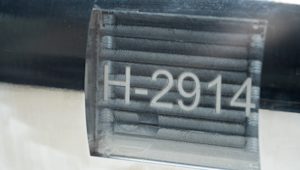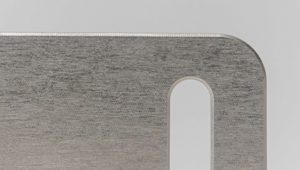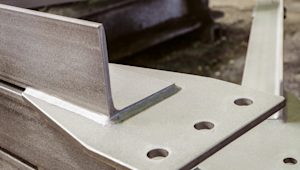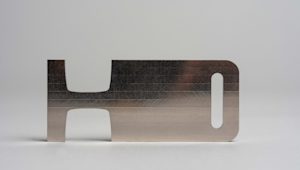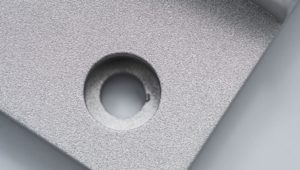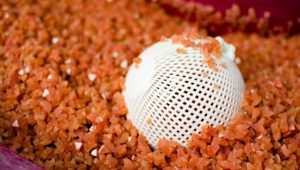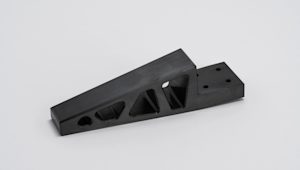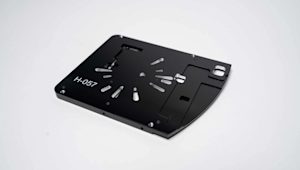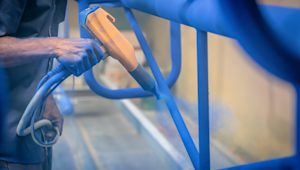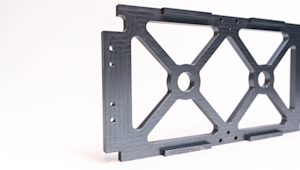Media blasting is a post-processing technique used to clean, finish, or prepare surfaces by forcibly propelling a stream of abrasive material against them. It is often used to remove rust, paint, or other contaminants, as well as shape and smooth surfaces. In this article, we’ll take a look at how media blasting works, commonly used materials,
How does media blasting work?
Media blasting typically involves the use of compressed air or water to propel abrasive materials – called “media” – at high speeds onto a part’s surface. The abrasive material, called “media” results in a clean and properly prepared surface for further treatment or finishing.
What is the difference between media blasting and bead blasting?
Whereas media blasting is a more general term that includes various abrasive materials, bead blasting specifically involves the use of small, spherical beads. Essentially, bead blasting is a type of media blasting. Learn more about bead blasting.
What materials are used in media blasting?
The choice of abrasive material used in media blasting depends on the specific application and the desired outcome. Here, we’ll take a look at several materials our customers commonly use for media blasting.
Sand. Media blasting with sand – called sandblasting– involves using sand as the abrasive material. However, silica sand, which was traditionally used, is now avoided in
-
many applications due to health concerns related to silica dust inhalation. Alternatives such as garnet, olivine, and aluminum oxide are often used instead.
-
Glass beads. Tiny spherical beads made of glass are used for bead blasting. Glass bead blasting is known for producing a smoother and softer finish on surfaces. It's commonly used in applications where a more delicate touch is required.
-
Aluminum oxide. A popular choice for media blasting due to its hardness and durability, aluminum oxide is effective in removing paint, rust, and corrosion.
-
Walnut shells. Crushed walnut shells are used as a less abrasive option, and are ideal for cleaning surfaces without causing damage. Walnut shell blasting is often used in applications where a gentler touch is required, such as cleaning softer materials.
-
Steel grit and steel shot. These abrasives consist of small steel particles and are commonly used for heavy-duty applications such as removing tough coatings, scale, and corrosion from metal surfaces.
-
Plastic media: Plastic media, such as acrylic, is used for sensitive applications where preserving the integrity of the substrate is crucial. It's often employed in industries like aerospace and automotive for delicate parts.
-
Corn cob grit. Crushed corn cob is another mild abrasive used in media blasting. It's often chosen for cleaning wood or delicate surfaces.
-
Ceramic beads. Ceramic beads are durable and provide a consistent finish. They are often used in precision cleaning and deburring applications.
-
Soda bicarbonate (baking soda). Baking soda blasting is a gentler option, commonly used for cleaning surfaces without causing damage. It's particularly useful for removing contaminants from sensitive materials.
What are the advantages of media blasting?
Media blasting efficiently removes rust, paint, and contaminants from surfaces. Here’s a closer look at a few of media blasting’s benefits.
-
Surface preparation. Media blasting is an effective method for preparing surfaces before painting, coating, or bonding. It removes rust, old paint, scale, and other contaminants, providing a clean and properly prepared surface for subsequent treatments.
-
Versatility: Media blasting can be used on a variety of surfaces, including metal, wood, concrete, and more. Different types of abrasive media can be used to suit the specific requirements of the material being treated.
-
Precision: Media blasting allows for precise control over the amount of material removed. The pressure, type of abrasive media, and angle of application can be adjusted to achieve the desired level of surface preparation without causing damage.
-
Efficiency. It is a quick and efficient method for removing coatings and contaminants from large surfaces or intricate parts.
-
Cost-effectiveness. Compared to other methods of surface preparation, media blasting can be a cost-effective option, especially considering the speed at which it can be achieved.
What industries use media blasting?
Media blasting finds applications in various industries. The following are several in which our customers that use media blasting tend to operate.
-
Automotive. Media blasting is used in the automotive industry for tasks such as paint removal, rust removal, and surface preparation before painting or coating. It is employed in both the production of new vehicles and the restoration of classic cars.
-
Construction. Media blasting can remove coatings, graffiti, and corrosion from concrete, metal, and other materials.
-
Marine: Shipyards use media blasting to clean and prepare ship surfaces for painting, coating, or maintenance. It helps in removing rust, barnacles, and old paint from ship hulls and other marine structures.
-
Aerospace. In the aerospace industry, media blasting is used for cleaning and preparing aircraft components. It helps remove old paint, corrosion, and contaminants from surfaces before maintenance or repainting.
-
Manufacturing. Various manufacturing industries use media blasting for surface preparation before painting or coating. It is applied in the production of metal components, machinery, and other fabricated products.
Best practices for media blasting
Here are a few best practices to keep in mind when designing a part that will be media blasted. By following them, you will be more likely to achieve a final part that is as close to your specifications as possible, while reducing cost and lead time.
-
Avoid sharp corners and edges. Abrasive media tends to impact areas with sharp corners or edges more intensely, potentially causing overblasting or uneven surface finishes. To mitigate this, consider adding fillets or chamfers to corners, promoting a more uniform blasting effect and preventing excessive material removal.
-
Surface finish requirements. Different media blasting techniques and media types can achieve varying degrees of roughness or smoothness. Communicate your expectations to your manufacturing part, and design the part accordingly. If a consistent surface finish is critical, ensure that the part geometry allows for uniform blasting across its entire surface.
-
Think about part orientation. Some surfaces may be more challenging to access or may receive uneven blasting depending on the orientation. Design the part so that critical surfaces are easily reachable, and the blasting media can uniformly impact all necessary areas. This may involve adjusting the part's orientation in the design or incorporating features that facilitate media flow.
-
Geometry considerations. Avoid complex or intricate shapes that might be challenging to reach with the blasting media. Instead, opt for designs that allow for even blasting coverage and consistent finishing results.
-
Tolerance and thickness. Media blasting can remove material from the surface, affecting the final dimensions. To mitigate this, ensure that the part's critical dimensions are within tolerance even after the blasting operation.
Get parts media blasted
To get a quote for any type of custom part, upload a CAD file and select the “media blasting” option at the checkout. If you have a special request, contact networksales@protolabs.com for personalized advice.
You can also read more about the surface finishes we offer, and advice for choosing the correct finish for your project.
Frequently asked questions
Which materials are suitable for media blasting?
Most metals, ceramics, and some plastics can undergo media blasting. Consult with your account manager to ensure compatibility.
What types of abrasive media are commonly used in media blasting?
Sand, aluminum oxide, glass beads, and steel shot are common abrasive media. Selection depends on the application and desired surface finish.
Can media blasting damage my part?
Improper settings or the wrong type of abrasion can damage delicate surfaces. Communicate the intended use of your part with our team, so we can help you to adjust the design.
What surface finishes can media blasting achieve?
Media blasting can produce finishes ranging from coarse to fine, depending on the abrasive media used and the blasting parameters.
How does part geometry affect media blasting?
Complex geometries may be challenging to blast uniformly. Design with accessibility in mind to achieve consistent results.
Can media blasting be used for rust removal?
Yes, media blasting is an effective method for removing rust and corrosion, leaving a clean surface ready for further treatment or coating.








